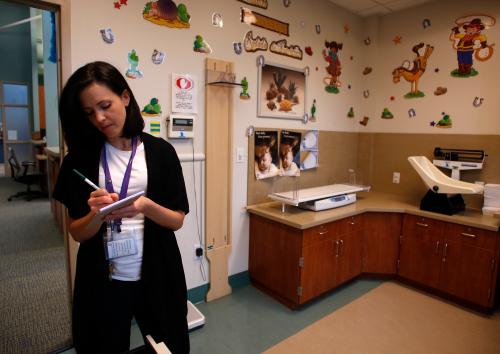This blog is part of a series highlighting policy proposals from Richard Reeves and Isabel Sawhill’s 2020 A New Contract with the Middle Class.
Children do best when their parents have the resources to care for them, one reason why President Biden recently overhauled the Child Tax Credit to give low- and middle-income families more money. While the significant cash transfer is set to slash poverty and boost children’s social mobility by improving families’ economic security, policymakers should also work to ensure that children have family stability.
As Richard Reeves and Isabel Sawhill wrote in A New Contract with the Middle Class, the relational health of the American middle class is not as good as it ought to be given our resources as a nation, and family life is under more stress. After trending downwards for the last few decades, marriage rates in the middle class have stabilized, although at a lower level than for the affluent. More children are being born outside marriage – mostly to cohabiting couples, rather than to single parents. Parents-to-be are now three times more likely to cohabit after getting pregnant for the first time than to get married, entering what some scholars call “shot-gun cohabitations.” These trends, often associated with poor families, can be seen in the middle class, too.
 For the full selection of charts and figures, see A New Contract with the Middle Class.
For the full selection of charts and figures, see A New Contract with the Middle Class.
A stable family environment for raising children, typically with two committed parents, is an ideal shared by most Americans. And strong family relationships provide a foundation for individual development, especially for children; investment of time and energy by parents strongly impacts child well-being and development. Family stability – with few or no changes in parents’ residential and romantic partnerships – is associated with better educational and social outcomes for children, especially boys. This is why parenting is so important.
Reeves and Sawhill write, “The goal for public policy, then, should be to help people construct the foundations upon which a stable family life can be built. That means providing Americans with economic security and higher incomes, the opportunity to acquire skills and education, reducing the time pressures on parents, and providing well-informed access to effective reproductive health care.”
Family planning = family stability
A stable family life is much easier to create, according to Reeves and Sawhill, when parents have adequate economic resources, job security, and time (and control over their time) to spend on their children and partners. It’s also critical that they are able to choose when and with whom to have children. Parents with some measure of economic security who intentionally have a child together at the time they prefer are much more likely to stay together. Currently, one-in-three births in the U.S. are unintended; among unmarried women under the age of 30, most births – 60 percent – are unintended. Young adults who “drift” into parenthood rather than planning their families are much more likely to experience significant instability in their relationships.
They add, “Family stability matters. But stability today may not look the same as it did in decades past, and it is important not to succumb to ‘bring backery’ based on a faulty presumption of a previous golden age.” Families may once have been larger and more stable, but domestic violence, child abuse, gender inequality, and the stigma attached to the unmarried and to same-sex couples were also far greater. Divorce as an exit from bad marriages, for example, has been a step forward, leading to fewer suicides among women and less domestic abuse. Perhaps neighborhood-centered communities were once more cohesive, but those neighborhoods were even more segregated along racial lines than they are today.
If the old norm was children within marriage, the new norm outlined in the Contract is to have children brought into the world intentionally. The good news is that supporting parents to plan their families is easier today than at any time in history thanks to the availability of safe, long-acting forms of contraception, such as intrauterine devices (IUDs). Since they are much more effective than other forms of contraception, their use dramatically reduces unplanned pregnancies as well as abortions.

States that have trained providers in the use of IUDs or other long-acting contraceptive methods — or made them available for free with good patient-oriented counselling — have experienced marked declines in unplanned pregnancies and abortions. A $1 billion investment in improving access to the most effective long-acting forms of contraception would produce an estimated $3.2 billion to $6.4 billion in increased earnings for children whose birth was timed to align with their own parents’ preferences. While ensuring access to health care providers in general is an important goal, Reeves and Sawhill outline specific proposals for increasing access to reproductive care in the Contract:
- A new question should appear on medical intake forms, asking women of childbearing age if they wish to get pregnant or not. This “one key question” should catalyze a discussion of (or referral to) contraceptive services if a woman does not want to get pregnant, or to pre-pregnancy health advice if she does. Other ways to improve awareness include social marketing campaigns and better sex education in schools.
- Cost. Contraception should be readily available at no cost, regardless of insurance status. The initial cost of the most effective forms of contraception, such as the IUD, is high – but much lower than the costs of an unplanned birth.
- Provider training. Medical schools and non-profits such as Upstream should be funded to train health providers, especially those in public health clinics. This additional training has been shown, for example in Delaware, to increase the use of effective forms of contraception, and reduce unplanned pregnancies and abortions dramatically.
Healthy, stable families depend on well-informed family planning. Accordingly, Reeves and Sawhill suggest that policymakers should ensure that parents-to-be are able to choose when to have children by improving access to high-quality contraception.





Commentary
Support children by empowering parents with family planning resources
June 9, 2021